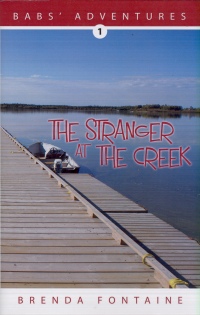| ________________
CM . . . . Volume XVI Number 5. . . .October 2, 2009. 
 |
The Stranger at the Creek. (Babsí Adventures, #1).
Brenda Fontaine.
Norway House, MB: Goldrock Press (www.dorenemeyer.com), 2009.
88 pp., hardcover, $19.95.
ISBN 978-0-982164-2-3.
Grades 2-4 / Ages 7-9.
Review by Gail de Vos.
**/4
|
| |
|

excerpt:
They traveled fast with the wind carrying them upon the crests of the white capped lake toward the islands of the fishermen. They followed the buoys although they didnít have to. Every once in a while, a rogue wave would splash into their boat and spray them as they turned around a marker. The hull would pound upon a swell. The women would brace themselves and grab the edges as it jarred their bodies. Cold air seeped under the covering and chilled Babs. The wind would jolt the vessel to the side and toss it upward until it again was traveling with it. But such was the life of a fisherman and his family, and they were used to it.
After a while, they saw the islands looming closer. The children poked their heads above the tarp relieved that they were soon heading for calmer waters. They would prefer to be sitting on the bench rather than uncomfortably at the bottom of the boat. They would grab one of the ribs whenever a huge wave would rock the boat. Soon they were into the channel among the islands and the waves downsized and became moderate undulations.
The Stranger at the Creek offers a gentle slice-of-life view of eight-year-old Babs and her family as they spend some time at their fishing camp in the summer during the early 1950s in northern Manitoba. It, unfortunately, does not offer the type of mystery or suspense that may have been aimed for with the inclusion of the secondary story of Pete, the stranger of the subtitle who had lived in the area for 20 years. The inclusion of this narrative seems to serve only as a device for the telling of the straightforward tale of a fairly contemporary Cree family.
Babs, her nine-year-old brother James, their parents and grandparents are the focus of the story as the reader follows the daily adventures with its minute details in preparing food, clothing and their religious beliefs and practices. Often the writing is didactic as exemplified when explaining their variant of the game of hopscotch.
While flashes of anticipation and adventure are offered momentarily, the author carefully negotiates the reader away from any possible emotional involvement with the characters or their situation. There is no real drama involving the rescue of Grandpa in his boat, the encounter with the bear, or when another family is caught in a small boat on the stormy lake. Or indeed, with the stranger at the lake!
The three full page black-and-white illustrations offer, also, a static view of the characters and their environment. The depiction of family life is of value for collections of First Nations material, but most young readers may find the descriptive language and static scenes unsatisfactory.
Recommended with reservations.
Gail de Vos teaches at the School of Library and Information Studies for the University of Alberta and is the author of eight books on storytelling and folklore.

To comment on this title or this review, send mail to
cm@umanitoba.ca.
Copyright © the Manitoba Library Association. Reproduction for personal use is permitted only if this copyright notice is maintained. Any other reproduction is prohibited without permission.
NEXT REVIEW |
TABLE OF CONTENTS FOR THIS ISSUE- October 2, 2009.
AUTHORS |
TITLES |
MEDIA REVIEWS |
PROFILES |
BACK ISSUES |
SEARCH |
CMARCHIVE |
HOME |
